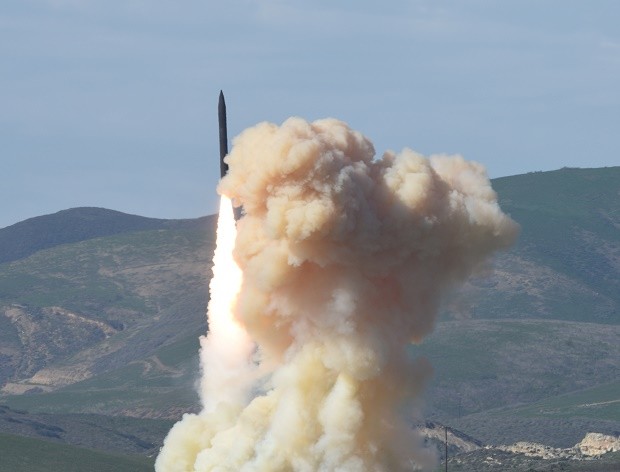North Korean nuclear threats spotlight US missile defense

This photo provided by the Defense Department’s Missile Defense Agency, taken Jan. 28, 2016, shows a long-range ground-based interceptor is launched from Vandenberg Air Force Base, Calif. As North Korea rattles its nuclear saber and threatens to bomb the U.S. at “any moment,” a nerve-jangling question hangs in the air: If North Korea did launch a nuclear-armed missile at an American city, could the Pentagon’s missile defenses shoot it down beyond U.S. shores? AP
WASHINGTON — As North Korea rattles its nuclear saber, threatening to bomb the US at “any moment,” a nerve-jangling question hangs in the air: If Pyongyang did launch a nuclear-armed missile at an American city, could the Pentagon’s missile defenses overcome their spotty test record and shoot it down beyond US shores?
America has never faced such a real-life crisis, and although officials say they are confident the defenses would work as advertised, the Pentagon acknowledges potential gaps that North Korea or others might be able to exploit, someday if not immediately.
One possible vulnerability involves a foe’s “countermeasures,” or decoys carried aboard long-range offensive missiles to fool a US interceptor missile into hitting the wrong target.
The Pentagon has poured at least $84 billion into missile defense over the past decade and is planning to spend another $3.3 billion over the next five years for a single element of the system, known as Ground-based Midcourse Defense, or GMD. Its key part is a network of interceptor missiles designed to launch from underground silos, fly into the path of an enemy missile as it arcs through space and smash into it, destroying it.
That system has failed three of its last four intercept tests. The only success in that series was the most recent test, in June 2014.
Article continues after this advertisementA congressional watchdog agency, the Government Accountability Office, said in February that the Pentagon “has not demonstrated through flight testing that it can defend the US homeland against the current missile defense threat.”
Article continues after this advertisementAdm. William Gortney, America’s homeland defender as head of US Northern Command, told Congress this month that the nation needs “more capable forces and broader options.” Key improvements are in the works, including a “long-range discrimination” radar for more effective tracking of incoming missiles.
The North Koreans’ harsh rhetoric, including a threat in February to deal “fatal blows at the US mainland any moment,” is linked in part to its anger at US-South Korean military exercises, which the North sees as a rehearsal for an invasion.
READ: North Korea claims more progress in missile development
No one is predicting a bolt-out-of-the-blue North Korean nuclear attack, but the threat looms larger as the North Koreans seemingly move closer to fielding a nuclear-armed missile that can reach US territory. Already this year they have claimed a successful H-bomb test, put a satellite into space orbit and claimed a successful simulated test of the warhead re-entry knowhow needed for a missile strike on the United States.
On Thursday, the North claimed to have successfully tested a solid-fuel rocket engine which, if true, would mark a significant further technological advance. The use of solid fuel reduces launch preparation time and thus shortens warning time for US defenses.
More appears to be in store. State-run media reported earlier this month that leader Kim Jong Un ordered preparations for a “nuclear warhead explosion test” soon and test-firings of “several kinds of ballistic rockets able to carry nuclear warheads.” With increasing regularity, the North Koreans are claiming major advances on the nuclear front that have caught Washington’s attention, even if they are exaggerated.
President Barack Obama, who plans to address 50 heads of state gathered in Washington this week for a nuclear security summit, has said North Korea’s pursuit of nuclear and missile programs “increasingly imperils the United States.”
Of particular worry is a long-range missile under development in North Korea that the US calls the KN-08. The Pentagon’s most recent public report on North Korea says the KN-08 has a range of more than 3,400 miles (5,470 kilometers), putting it into the category of an intercontinental ballistic missile, or ICBM.
Gortney said the KN-08 has “profound implications,” especially if it is deployed as a road-mobile weapon, meaning it could be moved and launched from vehicles that make it less vulnerable to detection. Such mobility, he said, would enable the North Koreans to elude or confound traditional US pre-launch warning systems.
Gortney says the North Koreans may have figured out how to make a nuclear warhead small enough to fit atop a KN-08 missile.
“While the KN-08 remains untested, modeling suggests it could deliver a nuclear (weapon) to much of the continental United States,” Gortney told a Senate panel March 10.
The segment of US missile defenses designed to stop a long-range North Korean missile are the interceptors based at Fort Greely, Alaska, and Vandenberg Air Force Base in California. Three years ago this month, then-Defense Secretary Chuck Hagel announced that the Pentagon would increase the number of deployed interceptors to 44 by putting an extra 14 at Fort Greely. The price tag for that expansion, initially put at $1 billion, has jumped to $1.5 billion.
READ: S. Korea and American allies face ‘miserable end’, says N. Korea
None of the extra 14 interceptors has been deployed yet, but all are to be in place by the end of next year. Defense Secretary Ash Carter told a House committee last week that the Pentagon also is working on a more effective “kill vehicle,” which is the device attached to the top of an interceptor; its internal guidance system helps steer it into an oncoming missile, destroying it by force of impact.